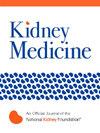Acute Kidney Injury Prognosis Prediction Using Machine Learning Methods: A Systematic Review
IF 3.2
Q1 UROLOGY & NEPHROLOGY
引用次数: 0
Abstract
Rationale & Objective
Accurate estimation of in-hospital outcomes for patients with acute kidney injury (AKI) is crucial for aiding physicians in making optimal clinical decisions. We aimed to review prediction models constructed by machine learning methods for predicting AKI prognosis using administrative databases.
Study Design
A systematic review following PRISMA guidelines.
Setting & Study Populations
Adult patients diagnosed with AKI who are admitted to either hospitals or intensive care units.
Search Strategy & Sources
We searched PubMed, Embase, Web of Science, Scopus, and Cumulative Index to Nursing and Allied Health for studies published between January 1, 2014 and February 29, 2024. Eligible studies employed machine learning models to predict in-hospital outcomes of AKI based on administrative databases.
Data Extraction
Extracted data included prediction outcomes and population, prediction models with performance, feature selection methods, and predictive features.
Analytical Approach
The included studies were qualitatively synthesized with assessments of quality and bias. We calculated the pooled model discrimination of different AKI prognoses using random-effects models.
Results
Of 3,029 studies, 27 studies were eligible for qualitative review. In-hospital outcomes for patients with AKI included acute kidney disease, chronic kidney disease, renal function recovery or kidney failure, and mortality. Compared with models predicting the mortality of patients with AKI during hospitalization, the prediction performance of models on kidney function recovery was less accurate. Meta-analysis showed that machine learning methods outperformed traditional approaches in mortality prediction (area under the receiver operating characteristic curve, 0.831; 95% CI, 0.799-0.859 vs 0.772; 95% CI, 0.744-0.797). The overlapping predictive features for in-hospital mortality identified from ≥6 studies were age, serum creatinine level, serum urea nitrogen level, anion gap, and white blood cell count. Similarly, age, serum creatinine level, AKI stage, estimated glomerular filtration rate, and comorbid conditions were the common predictive features for kidney function recovery.
Limitations
Many studies developed prediction models within specific hospital settings without broad validation, restricting their generalizability and clinical application.
Conclusions
Machine learning models outperformed traditional approaches in predicting mortality for patients with AKI, although they are less accurate in predicting kidney function recovery. Overall, these models demonstrate significant potential to help physicians improve clinical decision making and patient outcomes.
Registration
CRD42024535965.
使用机器学习方法预测急性肾损伤预后:系统综述。
理由与目的:准确估计急性肾损伤(AKI)患者的住院结果对于帮助医生做出最佳临床决策至关重要。我们的目的是回顾机器学习方法构建的预测模型,用于使用管理数据库预测AKI预后。研究设计:遵循PRISMA指南进行系统评价。设置和研究人群:被诊断为AKI的成年患者,他们被医院或重症监护病房收治。检索策略和来源:我们检索了PubMed, Embase, Web of Science, Scopus和Cumulative Index to Nursing and Allied Health,检索了2014年1月1日至2024年2月29日之间发表的研究。符合条件的研究采用机器学习模型基于管理数据库预测AKI的住院结果。数据提取:提取的数据包括预测结果和总体、具有性能的预测模型、特征选择方法和预测特征。分析方法:纳入的研究通过质量和偏倚评估进行定性综合。我们使用随机效应模型计算了不同AKI预后的混合模型判别。结果:3029项研究中,27项研究符合定性评价。AKI患者的住院结局包括急性肾病、慢性肾病、肾功能恢复或肾功能衰竭以及死亡率。与预测AKI患者住院期间死亡率的模型相比,模型对肾功能恢复的预测性能较差。meta分析显示,机器学习方法在死亡率预测方面优于传统方法(受试者工作特征曲线下面积,0.831;95% CI, 0.799-0.859 vs 0.772;95% ci, 0.744-0.797)。从≥6项研究中确定的住院死亡率的重叠预测特征是年龄、血清肌酐水平、血清尿素氮水平、阴离子间隙和白细胞计数。同样,年龄、血清肌酐水平、AKI分期、估计肾小球滤过率和合并症是肾功能恢复的常见预测特征。局限性:许多研究在特定的医院环境中建立了预测模型,但没有得到广泛的验证,限制了它们的推广和临床应用。结论:机器学习模型在预测AKI患者死亡率方面优于传统方法,尽管它们在预测肾功能恢复方面不太准确。总的来说,这些模型显示出帮助医生改善临床决策和患者预后的巨大潜力。注册:CRD42024535965。
本文章由计算机程序翻译,如有差异,请以英文原文为准。
求助全文
约1分钟内获得全文
求助全文

 求助内容:
求助内容: 应助结果提醒方式:
应助结果提醒方式:


